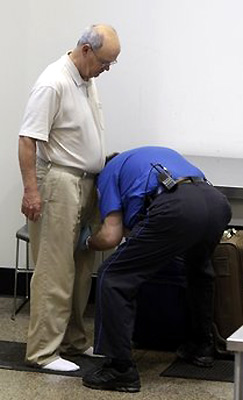Asia-Pacific
Pilots to be exempt from some airport checks: US
(Agencies)
Updated: 2010-11-20 15:20
 |
Large Medium Small |
DALLAS - Amid a growing protest against stepped-up and intrusive screening of airline passengers, the US government has cut a break for one very influential group of travelers - the pilots.
 |
|
A man undergoes a pat-down during TSA security screening, Friday, Nov. 19, 2010, at Seattle-Tacoma International Airport in Seattle. [Photo/Agencies] |
The victory for pilots followed a 2-year lobbying campaign by their union leaders that reached a fever pitch in the past two weeks. Their bid was boosted by hero pilot Chesley Sullenberger, who said pilots should be treated as "trusted partners" in the fight against terrorism.
But just days before the hectic Thanksgiving holiday travel period, TSA chief John Pistole offered little hope of a similar reprieve for regular passengers, who have complained more loudly about the new measures. Some are urging travelers to refuse to go through full-body scanners, which produce a virtually naked image.
If the loosely organized Internet campaign succeeds, security lines at the nation's airports could be snarled. Those who refuse a body scan can be forced to undergo time-consuming fingertip examinations, which include clothed genital areas and breasts, by inspectors of the same sex as the traveler.
| ||||
The pilots are avoiding that argument. American Airlines pilot Sam Mayer said it's a security matter for the TSA to decide. All he knows, Mayer said, is that intrusive screening for pilots makes little sense.
A pilot intent on terrorism could simply crash the plane. No amount of imaging at the security checkpoint could stop that. Besides, under another government program to make them the last line of defense against terrorists, pilots are allowed to have guns in the cockpit.
The changes promised by TSA on Friday are "basically what we've been after," Mayer said. "Pilots are not the threat here; we're the target."
Mayer's union, the Allied Pilots Association, helped foment the backlash against the security measures two weeks ago. Its president, Dave Bates, urged pilots to skip the imaging machines because of concern about frequent radiation exposure. The government and an independent group of experts say radiation is safe, as long as radiation doses are kept within the low limits set for the scanners.
Bates recommended that pilots instead accept a pat-down - preferably where passengers couldn't see them.
John Prater, president of the Air Line Pilots Association, which represents pilots at several major airlines, said the unions have been negotiating the changes with TSA for two years. He said changes were already in the works, but were speeded up by the backlash against the new imaging machines and searching techniques.
The TSA offered few details - and no specific timeline - for changes in screening of pilots, which expand a program tested at airports in Baltimore, Pittsburgh and Charlotte, N.C.
The TSA said beginning Friday, pilots traveling in uniform or on airline business could pass security by presenting two photo IDs, one from their company and one from the government, to be checked against a secure flight crew database. Their unions said pilots could skip the pat-downs immediately.
Pistole said pilots ensure the safety of millions of passengers every day, and that putting them through a faster screening process would be a more efficient use of the agency's resources. But the TSA chief has defended the more invasive inspections of passengers, saying they were a response to intelligence about potential terrorist attacks and plots to evade airport security.


